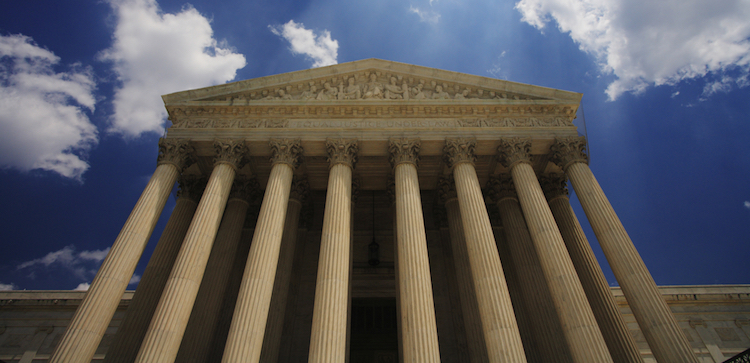Rail-Splitter, Tech User
Abraham Lincoln may have been the most technological lawyer of his time. One thing’s for sure, he managed to do more with less, as he did with his education. He is the ideal subject for a discussion of how a skilled 19th century lawyer would fit into 2st century technological practice.
When we started practice in the 1970s, the technological level of most lawyers seemed only slightly above the 19th century level. (OK, that is an overstatement, but not a huge one.) Electronic research did not exist, nor did the World Wide Web. The photocopier, typewriter, dictation recorder, telephone and air conditioner were the major law office advances since Lincoln. Otherwise, not that much was different in a typical office interior.
Courts in the early 1970s were also not so different, particularly state courts in rural counties. Many old courthouses still exist with architecture similar to that of the ones in which Lincoln practiced.
In the 1970s, docket calls scheduled trials; court administration was largely nonexistent as a separate entity. Universal, overnight delivery of letters and packages did not exist. The U.S. Supreme Court in the early ’70s did not even permit certification of mailing to be equivalent to filing. (David Hirsch once flew to Washington, D.C., at that time to physically file papers opposing a certiorari petition in order to use the full allotted time to prepare the filing–a curious combination of low tech and high tech.)
Clearly Abe Lincoln could have practiced in the early disco era without much culture shock. But what about the 21st century?
A recent visit to Springfield, Ill.–home of the technologically advanced Abraham Lincoln Presidential Library and Museum and other Lincoln historical sites–inspired some thoughts about what the young lawyer who would become our 16th president might do in the digitized world of today’s legal practice.
What you find is that Honest Abe could be seen as one attorney taking whatever advantage the technology of his day provided.
Automated Abe
Abe Lincoln is the only president to ever have a patent in his own name. (Patent No. 6469 was for a device, never created, to lift boats over shoals and shallow water.) He believed in technology and creatively used the crude 19th century tools available to improve his practice. A road warrior in his own right, he anticipated much of what we now take for granted and embraced the technology available to him.
One can imagine a 21st century Lincoln searching the Web for information regarding a full moon, much as he found that information in an 1857 almanac to win an acquittal in a murder trial.
The layout of the original Lincoln & Herndon law firm of the mid 1800s could pass for a 1970s law office but for a few issues. The office is on the third floor. The federal court was on the second floor. There was apparently a staircase that allowed visitors to go directly into Lincoln’s law office, bypassing the federal jury room.
The office’s convenient location, across the street from the state law library, made research nearly as convenient as a desktop computer.
Lincoln’s office was essentially a moderately large conference room containing an interesting trapdoor in the floor. The federal courtroom was just below, and Lincoln was used to stretching his long frame out on the floor when he wanted to relax (because he was too tall for the chairs of the time).
It was not unusual for him to prop up the trapdoor with a book, get on the floor and listen to what was going on in court. One can only imagine how much he learned from his convenient location. Now one might view appellate arguments on the Web or watch televised state district court proceedings when available. But Lincoln had his own real-time connection.
Displayed in Lincoln’s living room in Springfield is a small, portable desktop. The display is a replica because, as the guide explained, the original was very worn. One can imagine Lincoln taking the desktop with him as he rode the circuit–his version of a laptop office. There is a small desk upstairs in his home. Like many modern day road warriors, Lincoln did a lot of work at home.
Lincoln was a vocal advocate of improving roads in Illinois, even before he became a lawyer riding the circuit four or five months of the year. As early as 1830, Lincoln gave a speech advocating navigation improvements for the Sangamon River. In 1832 he still advocated river improvements, and he also spoke about roads. He recognized early the importance of transportation. And the Internet is essentially a transportation device, as are cars and airplanes.
Lincoln’s legendary and frequent collegial gatherings with judges and other lawyers to converse and exchange stories are not that different from today’s Internet mailing lists.
He Got T-Mail
President Lincoln’s camping out (literally) at the Western Union office during the Civil War shows a commander in chief hanging on every tidbit of news, much like current day lawyers depend on electronic mail and the World Wide Web. Take a look at the recently published Mr. Lincoln’s T-Mails: The Untold Story of How Abraham Lincoln Used the Telegraph to Win the Civil War by Tom Wheeler. Lincoln also expressed an interest in using balloons for reconnaissance.
When Lincoln showed up at the telegraph office, he read telegrams in reverse order: most recent to least recent–an efficient technique with e-mail. He recognized that controlling the information spigot was a key to command; as a result he switched the government’s telegraph services from military control (the generals) to civilian control (him and the secretary of war). This enabled him to get truthful accounts of the war and communicate directly with officers below his generals.
As Wheeler wrote: “At the heart of Abraham Lincoln’s use of the telegraph was his natural receptivity to new technology. Lincoln’s comfortable inclination toward innovative technological ideas was essential to his evolution as the first electronic leader. “Far from a backwoods rail splitter, Abraham Lincoln had a fascination with, and intuitive appreciation of, new technology. In the vernacular of today, Lincoln was an ‘early adopter.’ ”
Lincoln started practice in about 1836 and practiced law until about 1860. But the technology changes in the practice of law since the mid 1970s are in some ways greater than the changes from the time Lincoln ended his law practice to the mid 1970s.
Lincoln’s law files have been digitized, something most 21st century law firms have yet to accomplish. The $500 indexed DVD set (available from the University of Illinois Press) contains 5,600 matters, 96,000 documents and more than 210,000 pages. It is also available for viewing in many libraries throughout the United States.
Compared to today’s terabytes of digital documents, Lincoln’s files are puny. Each document averages a little more than two pages. Each matter averages about 37 pages. But it is not so much that law was simpler then, it’s just that writing documents by hand imposed its own limitations.
The outhouse behind Lincoln’s Springfield home is a crude reminder of how far civilization has come. The interactive museum and library, opened in 2005, points to a future Lincoln never dreamed of, yet helped make possible.
This Illinois rail splitter, shopkeeper, postmaster, surveyor, lawyer, congressman and president with just one year of formal education was no ordinary person. He could practice today, embracing technology.
Abe Lincoln practiced in a small firm in diverse areas of the law, among them commerce, divorce, debt collection, foreclosures, wills, criminal law, railroad law, patent suits and appeals.
In the mid 1970s, some small firms might have been able to handle that diverse a practice, but it would have been almost impossible.
In the 21st century, technology makes a diverse practice feasible again (despite the drive to specialize). There may be more required of lawyers today, but information is readily available.
Abe Lincoln in the 21st century would likely take technology to new heights without losing sight of the practical.
He showed in the 19th century that he had the natural intelligence to use technology the right way: to free himself from physical drudgery, to enhance his ability to travel and communicate, to increase his practice and to improve his ultimate legal product. To him, electronic filing would be like an improvement in river transportation, something that makes it easier to get a document to the clerk’s office.
Abe Lincoln, the ultimate lawyer, accustomed to hard work and a heavy caseload, was in his way the ultimate legal technologist.
According to Lincoln, the three most important discoveries and inventions in world history were:
• The introduction of patent laws.
• The development of writing and printing.
• The discovery of America.
Technology used properly may be defined not as freedom from work, but as freedom from otherwise necessary drudgery. Lincoln’s use and promotion of technology came naturally; it was his first emancipation proclamation.
David Beckman and David Hirsch are partners in the law firm of Beckman & Hirsch in Burlington, Iowa. Contact Beckman at [email protected] and Hirsch at [email protected].



